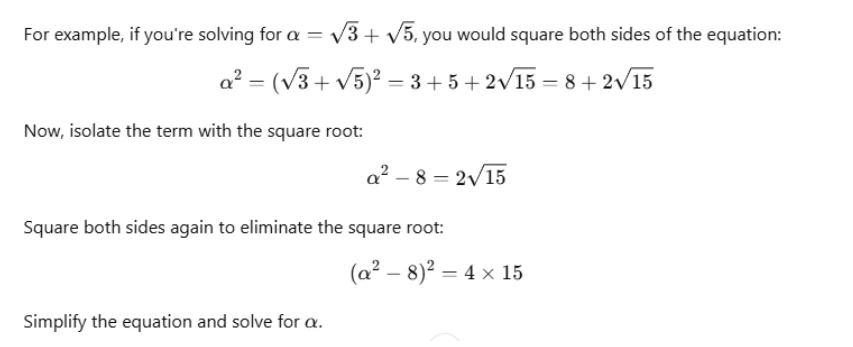How to Solve Complex MATLAB Assignments on Polynomial Equations

Mathematical assignments can be challenging, particularly when dealing with concepts like polynomials, irrational numbers, magic tricks, and new definitions like squarilarity. However, with a systematic approach and the right tools, students can easily tackle similar types of assignments. One such tool that can help simplify complex problems is MATLAB, a powerful programming language and environment used widely in academic settings for solving mathematical, engineering, and scientific problems. If you are tasked with assignments involving polynomial equations, rational and irrational numbers, or even abstract concepts like squarilarity, this guide is designed to help you break down the problems and solve them effectively using MATLAB. Additionally, students can use MATLAB to solve their Polynomial Equations assignment and other related mathematical challenges with ease. Here, we will explore different mathematical problems commonly seen in MATLAB assignments and guide you through a step-by-step approach to solving them. By the end of this guide, you will have a solid understanding of how to approach these types of problems and how MATLAB can assist in solving them.

1. Understanding Polynomials and Rational Numbers in MATLAB
A key concept that frequently appears in MATLAB assignments involves polynomials and rational numbers. A polynomial is a mathematical expression consisting of variables and coefficients, with integer coefficients considered integral. Polynomials are used to represent relationships and can have integer, rational, or irrational solutions. For example, a polynomial equation like:

Key Concepts:
- Polynomials and Integer Coefficients: A polynomial is integral if all the coefficients are integers. For example, x2−2=0 has integer coefficients, and solving for x results in the square root of 2, an irrational number.
- Rational and Irrational Numbers: A rational number is one that can be expressed as a ratio of two integers, i.e., a/b where a and b are integers and b≠0. An irrational number cannot be expressed in this form, like

When you encounter problems where you're asked to solve for an irrational number or check if a number is rational, these definitions are essential to know.
MATLAB Solution:
MATLAB offers several tools that help verify whether a number is rational or irrational. In particular, you can use symbolic computation to check the properties of numbers. To determine if the square root of 2 is irrational, you could use a simple MATLAB script:
x = sqrt(2); % Calculate the square root of 2
if ~isinteger(x) % Check if the number is not an integer
disp('The number is irrational');
end
This script will output "The number is irrational," confirming that 2 is indeed irrational.
Further Exploration:
You can extend this idea to solve similar problems involving polynomials. For example, suppose you're asked whether the square root of a non-square integer is rational. In this case, you can use MATLAB's sqrt function to evaluate the square root of any integer and verify its rationality.
c = 3; % Example non-square integer
y = sqrt(c); % Calculate the square root of 3
if ~isinteger(y)
disp(['The square root of ', num2str(c), ' is irrational']);
end
2. Solving Integral Polynomial Equations
A common task in assignments involves finding integral polynomial equations that have irrational numbers as solutions. For instance, you might be asked to find an integral polynomial equation that has α=3+5 as a solution.
Key Approach:
- Isolate Terms: Begin by isolating terms involving square roots.
- Square Both Sides: To eliminate the square roots, square both sides of the equation. This process can be repeated if multiple square roots are involved.
- Simplify: After squaring, simplify the resulting equation and reorganize terms to get an integral polynomial.

MATLAB Implementation:
To solve this in MATLAB, you can use the symbolic toolbox to work with equations involving square roots. Here's an example:
syms alpha
eq1 = (alpha^2 - 8) == 2*sqrt(15); % Define the equation
eq2 = eq1^2; % Square both sides to eliminate the square root
sol = solve(eq2, alpha); % Solve for alpha
disp(sol);
This code defines the equation, squares both sides, and solves for α, which is the irrational number you're trying to find.
3. Understanding and Solving Mathematical Tricks
Mathematical tricks or puzzles often appear in assignments as a way to test your understanding of basic operations and algebraic manipulations. One such puzzle involves performing a series of operations on a number and guessing the original value.
In the given puzzle, the steps include multiplying a number by 3, dividing it by 2, rounding down if necessary, and repeating this process. Eventually, you're asked to determine the original number based on the result.
Key Approach:
- Break Down the Trick: Understand the operations performed and how they affect the number.
- Translate into Algebra: Express the steps algebraically and solve for the original number.
- Verify: Use examples to verify the trick works with different numbers.
To simulate this trick in MATLAB, you can use the following code:
n = 19; % Assume the starting number is 19
result1 = floor((3 * n) / 2); % Step 1: Multiply by 3 and divide by 2, round down
result2 = floor((3 * result1) / 2); % Step 2: Multiply by 3 and divide by 2 again
quotient = floor(result2 / 9); % Step 3: Divide by 9 and round down
disp(quotient); % Display the quotient
By simulating this trick in MATLAB, you can gain a deeper understanding of the operations involved and learn how to reverse-engineer such tricks.
4. Exploring Fashionable Numbers and Their Properties
Another interesting problem involves exploring fashionable numbers and their properties. In this type of problem, you're asked to determine which numbers are considered fashionable according to specific rules.
Key Steps for Solving Fashionable Number Problems:
- Identify the Base Case: Start by understanding the rules for fashionable numbers. For example, 1 might be fashionable, and numbers like a+b may be fashionable if both a and b are fashionable.
- Characterize the Set: Once you know the rules, characterize the set of fashionable numbers and try to find patterns.
- Generalize: Think about how the set of fashionable numbers changes if the starting set is different.
In MATLAB, you can create a function to check whether a number is fashionable according to a given rule. Here’s an example where we check if a number is fashionable based on the rule:
function is_fashionable = checkFashionable(x)
% Define the base fashionable number (1)
if x == 1
is_fashionable = true;
else
% Check if it follows the rule of summing fashionable numbers
% Example rule: sum of 1 and any number
is_fashionable = mod(x, 2) == 0; % Simplified rule for this example
end
end
This function checks whether a number is fashionable by following a simple rule. You can modify the rule to match the specific problem you're working on.
5. Defining Squarilarity and Calculating It in MATLAB
One of the more creative problems you might encounter involves defining and calculating squarilarity, a measure of how much a shape resembles a square. The task is to define a numerical value between 0 and 1, with 1 representing a perfect square. Other shapes will have squarilarity values based on their proportions.
Key Steps for Defining Squarilarity:
- Define the Metric: Decide on a formula or method for measuring how similar a shape is to a square. For example, you could compare the ratio of side lengths or angles between sides.
- Validate the Metric: Ensure that the squarilarity value always falls between 0 and 1 and that squares have a value of 1.
- Explore the Implications: Test the metric with different shapes and observe any patterns.
Here’s an example of how you might define squarilarity in MATLAB:
function squarilarity = calculateSquarilarity(side_lengths)
% Assuming side_lengths is a vector with side lengths of the shape
if length(side_lengths) == 4 && all(side_lengths == side_lengths(1))
squarilarity = 1; % It's a square
else
squarilarity = 0; % Non-square shape
end
end
This function calculates squarilarity by checking if all four sides of a shape are equal. If they are, the shape is a square, and its squarilarity is 1.
Conclusion
By following these strategies and utilizing MATLAB, you can effectively tackle a wide range of mathematical problems, from polynomials and rational numbers to magic tricks and squarilarity. MATLAB's powerful computational capabilities make it an excellent tool for solving complex assignments and understanding mathematical concepts. Whether you're dealing with polynomials, irrational numbers, or creative problems like squarilarity, breaking down the problem step by step and using the appropriate MATLAB functions will help you achieve accurate solutions efficiently and enable you to solve their MATLAB assignment with confidence.